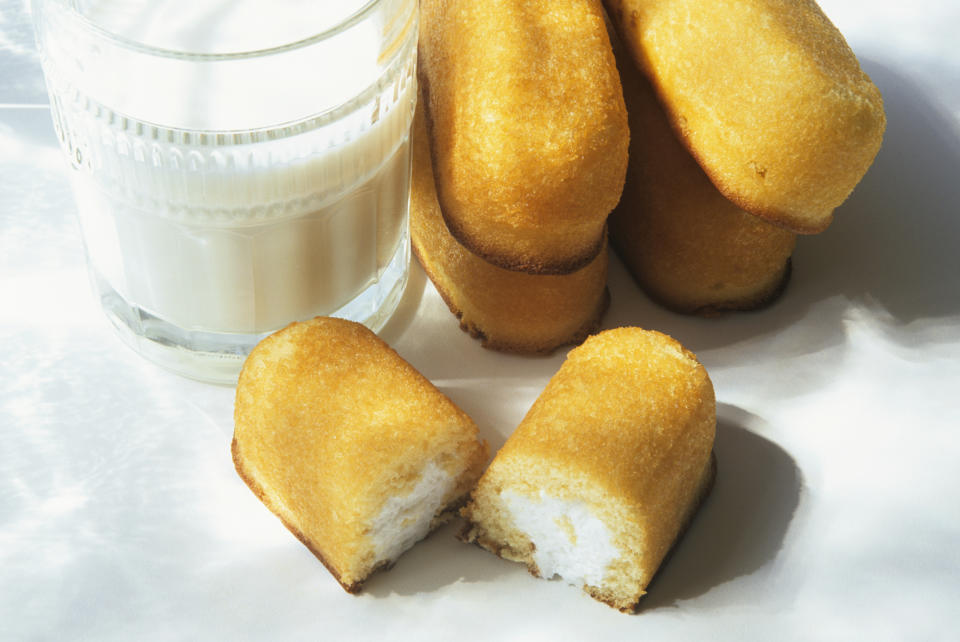Twinkies don't last forever — and here's photo evidence to prove it

Ever wondered what an 8-year-old Twinkie looks like? It’s not pretty.
Stuck indoors during the coronavirus pandemic and craving something sweet to eat, Colin Purrington, a nature photographer who taught evolutionary biology at Swarthmore College, told NPR he remembered he’d bought a box of Twinkies eight years ago and had left them in his basement. “When there’s no desserts in the house, you get desperate,” he told NPR.
Purrington, like many people, assumed that Twinkies simply lasted forever (the processed food has a shelf life of 45 days). But when he opened up the box, he was surprised by what he saw. While most of the Twinkies looked fine, the one he tried tasted awful — “like an old sock,” Purrington said.
He noticed that two other Twinkies looked odd — one had a large brown spot on it, while another one was completely unrecognizable: shriveled up and a disturbing brownish-grey.
After Purrington shared photos of his discovery on Twitter, two scientists who study fungi at West Virginia University — Matt Kasson, the interim director of the International Culture Collection of (Vesicular) Arbuscular Mycorrhizal Fungi, and Brian Lovett, a post-doctoral researcher in the Kasson Laboratory at the Division of Plant and Soil Sciences at West Virginia University — wanted to know more.
Kasson and Lovett asked Purrington to send over the samples to learn what had happened to the Twinkies.
We have a new terrifying mycology project called Operation #MoldyTwinkie. @lovettbr & I will ID an unknown fungus or fungi growing inside individually wrapped 8-year-old expired @Hostess_Snacks Twinkies. These moldy cakes were discovered in @colinpurrington's basement. @MSAFungi pic.twitter.com/dsQGKvjFsv
— Matt Kasson (@kasson_wvu) October 8, 2020
The scientists found fungus on both of the strange-looking Twinkies. Although they haven’t yet been able to grow fungus from samples taken from the “mummified”-looking Twinkie to identify which type had attacked it, the scientists believe they’ve pinpointed what caused the brown spot on the other Twinkie (which still had its creamy filling eight years later!): the mold Cladosporium.
“It’s a very common indoor mold,” Kasson tells Yahoo Life. “Not surprising to see it as a food contaminant. We find it on insects, plant tissues, table surfaces, etc.”
However, Kasson tells Yahoo Life that it’s not typical for packaged food like Twinkies to have fungi on them, “as many of the processes they have in place keep out microbes entirely or inhibit growth.”
Produce, on the other hand, is “certainly different as many fruits and vegetables are sold free of packaging and are susceptible to post-harvest microbes, including fungi entering from every point along the supply chain route.”
Kasson adds: “If we are talking about farmer’s market style, no preservatives, open-air products like baked breads, they too are vulnerable to airborne fungi. Think about the fresh rolls you purchase and how quickly they become moldy if you don’t use them.”
Yahoo Life did not immediately hear back from Hostess Brands, which makes Twinkies, for comment.
The other fungus infected cake still had a typical cream filled center! #MoldyTwinkie pic.twitter.com/GZDu2NZ261
— Matt Kasson (@kasson_wvu) October 8, 2020
‘Most food is not sterile’
Abigail Snyder, an assistant professor in the department of food science at Cornell University, tells Yahoo Life that “most food is not sterile — meaning, you may expect to find a very low level of different but harmless microbial cells on food products when you first purchase them.”
However, she adds: “You would not expect food to be perceptibly spoiled by high levels of microbial growth when you first buy it. If you can see visible mold growth on your food when you first buy it, unless it’s supposed to be there as part of the product — like for mold-ripened cheeses — then you may want to contact the retailer or manufacturer about getting a replacement or a refund.”
Snyder also says you should discard the moldy food and points to the United States Department of Agriculture’s food safety education fact sheet on mold.
But what happens if you accidentally eat food with some fungi on it?
“Most foodborne fungi cause quality issues — like discoloration, changes to flavor and texture, bloating of the package — and don’t result in foodborne illness,” explains Snyder. “However, if some molds have the chance to grow on foods in the right conditions, they can produce mycotoxins that, if consumed frequently or at very high levels, can result in illness.”
Kasson says that people unknowingly eat food with fungi growing on them “all the time — leftovers, older produce, etc.” We don’t always see these fungi, but you’ll likely taste the difference. “The greater the fungal colonization, the less appetizing it likely is,” explains Kasson. “You’d probably spit it out as soon as it hit your tongue. Fungi secrete a lot of different compounds as they grow through any given substrate, so this will certainly modify the taste.”
He says that sticking with the “best by” dates on packaged food at least can help reduce the likelihood that fungi is proliferating on or in your food. Adds Snyder: “For optimum quality, consumers should try to consume food they purchase by the ‘best by’ date, but may still consume product even after that date if the quality level is still acceptable.”
Just don’t wait eight years to eat your Twinkies.
Read more from Yahoo Life:
Here's how the CDC says you can celebrate Thanksgiving safely
Women use this facial expression to flirt most effectively: ‘It’s very powerful’
Want lifestyle and wellness news delivered to your inbox? Sign up here for Yahoo Life’s newsletter.

 Yahoo Sports
Yahoo Sports 